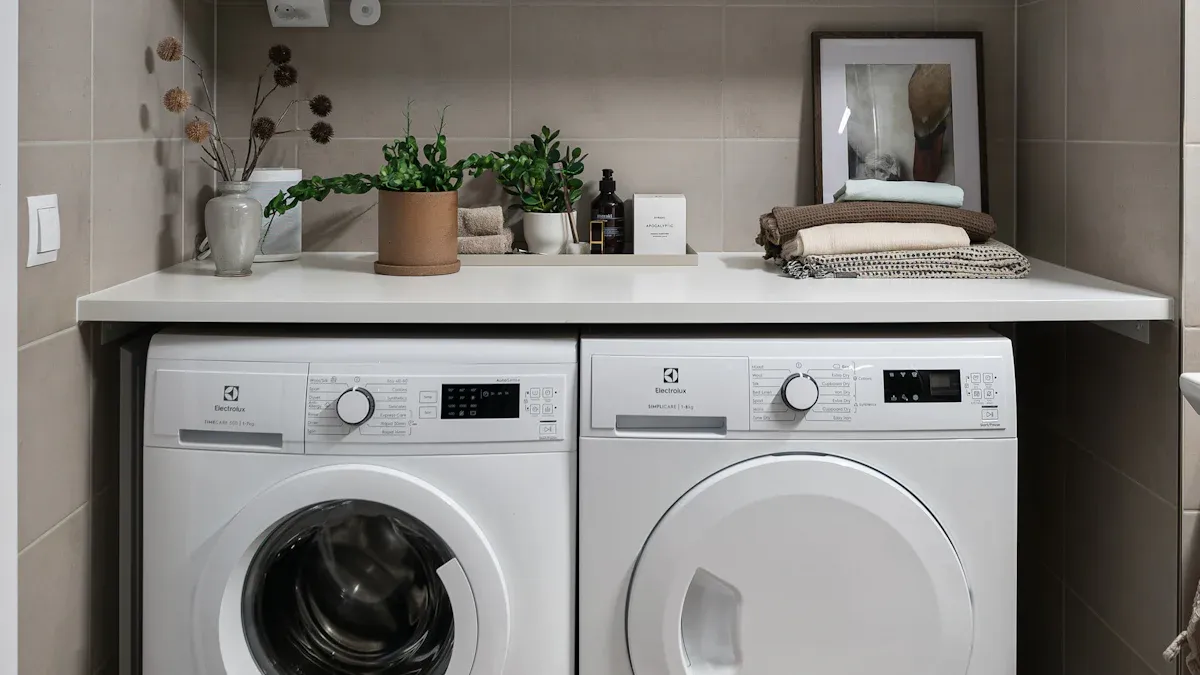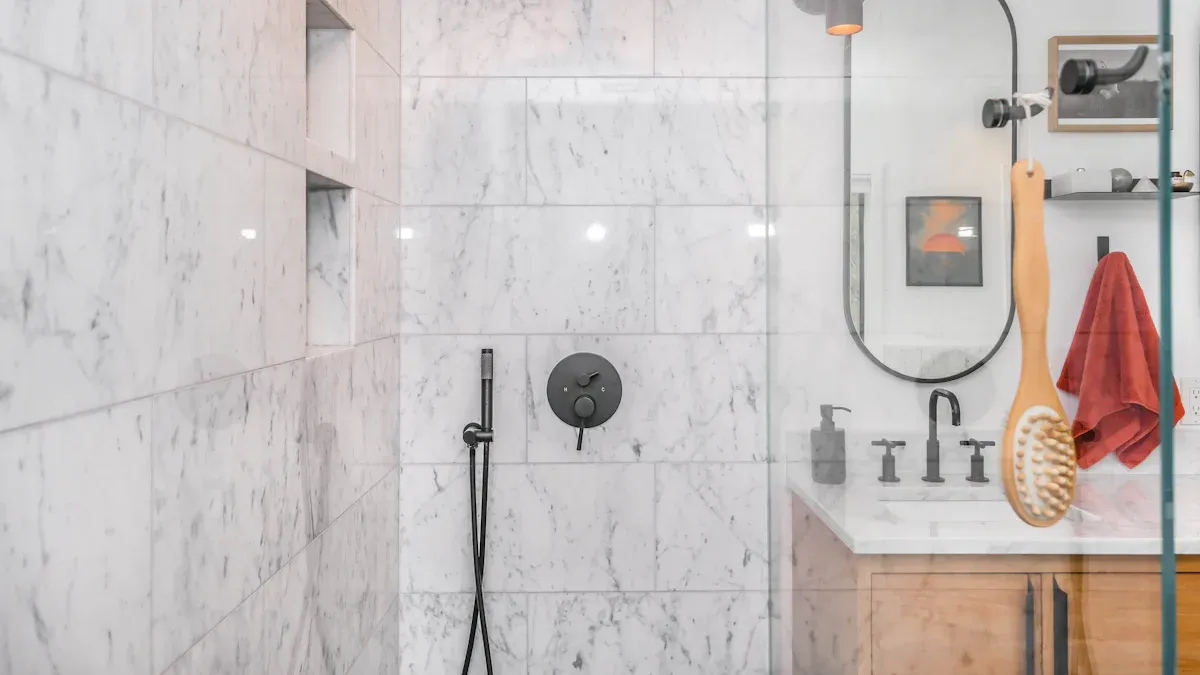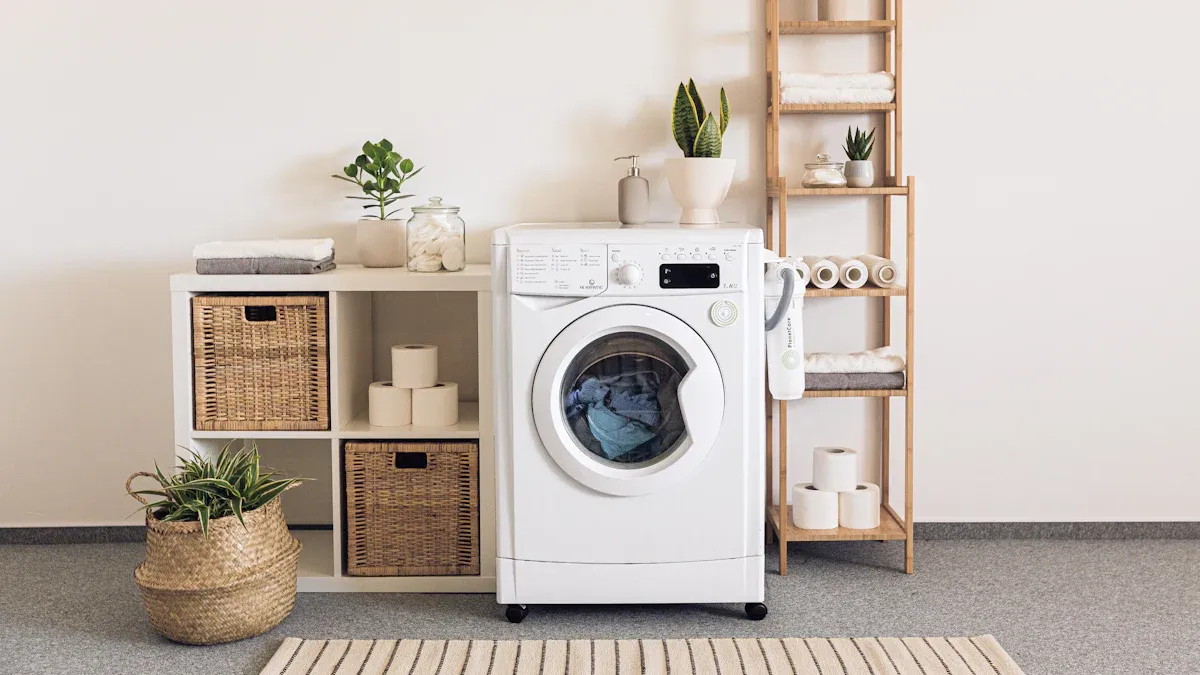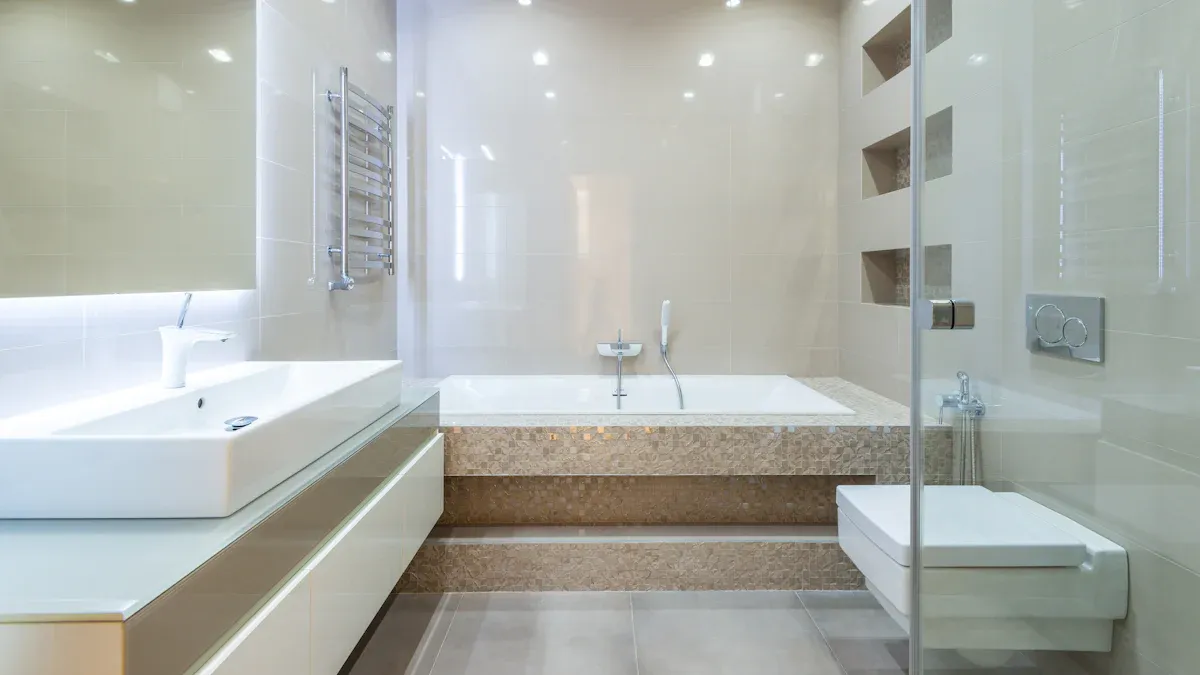
13 Oct 7 Essential Spots in Your Home for Mold Resistant Wall Panels
Table of Contents
You want your home to be free of mold. But did you know about 70% of homes have mold?
Description
Allergic Reactions
Stuffy nose, cough, burning eyes, or skin rash
Severe Reactions
Asthma or allergy sufferers may react strongly
Bathrooms, basements, laundry rooms, and kitchens need mold resistant wall panels. This helps stop mold from growing in these places.
Key Takeaways
Mold-resistant wall panels are important in places with lots of moisture like bathrooms, kitchens, and laundry rooms. They stop mold from growing and keep you healthy.
To install mold-resistant panels the right way, use waterproofing behind them and seal all the edges. This keeps water out and protects your home for a long time.
You should check for leaks often and make sure air can move well. Doing this helps your home stay free of mold and keeps everyone healthy.
Bathroom

Mold Resistant Wall Panel Benefits
After you shower, your bathroom feels wet. The air is humid and there is a lot of water. This makes it easy for mold to grow. If you do not fix this, mold can spread fast. Mold can make you sick. Mold resistant wall panels help keep your bathroom safe and clean.
Let’s see how PVC panels help in bathrooms:
Property | PVC Panels Effectiveness |
|---|---|
Works very well in wet places | |
Antibacterial Coating | Stops mold from growing, keeps walls clean |
Durability | Does not break or bend in wet rooms |
Health Impact | Lowers chances of asthma and allergies |
These panels block water from getting into the walls. Mold cannot stick to the walls. Your home stays healthier. You worry less about allergies or asthma.
Installation Tips
You want to install panels fast and easy. Many mold resistant wall panels have simple locks. You can finish putting them up in one or two days. Here are some things to remember:
Mold resistant wall panels can cost half as much as tiles when you add up materials, labor, and care.
Wet-wall panels go up faster, usually in 1-2 days.
They need less cleaning, so you save money over time.
Before you start, use waterproofing behind the panels. This stops water from getting into the walls. Seal all edges and corners well. Bathrooms, kitchens, and laundry rooms need extra care because they stay damp. With good wall panels and waterproofing, your bathroom will be safe from mold for a long time.
Kitchen
Moisture Control
You spend a lot of time in your kitchen. Cooking, washing dishes, and cleaning all add moisture to the air. If you ignore this, you might see mould on your walls or ceiling. Moisture comes from many places in kitchens:
Leaks in pipes or appliances
Spills and standing water after cleaning
Condensation on cold surfaces
When moisture builds up, mold growth can start quickly. You want to keep your kitchen dry and fresh. Open windows when you cook, use your exhaust fan, and check for leaks often. These simple steps help stop mould before it spreads.
Mold Resistant Wall Panel Use
You want your kitchen to look good and stay healthy. Mold resistant wall panel installation is a smart choice. PVC panels work best in kitchens because they have a smooth, non-porous surface. Mold cannot stick to them. These panels are 100% water-resistant and last much longer than other options. FRP panels are strong, but their crevices can trap moisture and lead to mold growth.
Here’s how you can install wall panelling with proper waterproofing:
Remove any damaged drywall and fix moisture problems.
Clean your workspace and gather all tools.
Measure and cut panels for a perfect fit.
Secure panels to studs with screws.
Seal seams with joint compound and tape.
Keep humidity low with dehumidifiers and good ventilation.
Tip: Always use proper waterproofing behind panels to protect your home from hidden moisture.
A kitchen with mold resistant wall panels stays clean and safe. You spend less time worrying about mould and more time enjoying your home.
Laundry Room

Mold-Resistant Drywall
Laundry rooms often get very humid. Washing and drying clothes puts a lot of moisture in the air. If you do not control this, mold can grow on walls or ceilings. Let’s see how laundry adds moisture compared to other things at home:
Source of Humidity | Moisture Production Rate |
|---|---|
Depends on machine speed | |
Human respiration | Measured in special tests |
Cooking (e.g., boiling) | Adds a lot of moisture |
Fast washing machines add even more moisture. This makes laundry rooms important for stopping mold. Mold-resistant drywall works better than regular drywall in wet places. Here is a simple comparison:
Type of Drywall | Performance in Humidity | Cost Consideration | Maintenance Needs |
|---|---|---|---|
Standard Drywall | Gets damaged by water | Cheapest option | Needs more repairs |
Mold-Resistant Drywall | Stops mold better | Costs more | Needs less upkeep |
Installation Considerations
You want your laundry room to stay dry and safe. Use waterproofing behind mold resistant wall panels or drywall. This keeps water away from the wall. Good wall panels help stop dampness and mold.
Here are some easy tips for a healthy laundry room:
Check walls and ceilings for water spots often.
Make sure your dryer vents outside and keep the hose clean.
Use a monthly checklist to look at hoses and under sinks.
Fix water damage or mold right away.
If your laundry room is close to basements or other wet places, be extra careful. With good materials and regular checks, you can keep your home fresh and mold-free.
Basements
Waterproofing Solutions
Basements often feel damp and smell musty. Not enough air and wetness help mold grow fast. To keep your basement dry, you need to stop water from getting in. Here are some easy ways to protect your home:
Fill cracks in the walls and floor to keep water out.
Put in a sump pump to move water away.
Use dehumidifiers to lower the wetness in the air.
Make sure gutters and pipes send water far from your house.
Add fans or vents to let air move better.
Experts say stopping water outside is the best way to keep basements dry. If you control wetness and let air flow, mold will not grow as fast. Wet air, warm rooms, and water drops all help mold show up. If you live where it is very humid, watch these things closely.
Tip: North-facing basement rooms usually have less mold than south-facing ones. Using thermal insulation helps keep walls dry.
Wall Panelling Options
You want your basement to look nice and stay safe. Mold resistant wall panels are a smart choice. These panels stop water and keep mold off your walls. Mold-resistant drywall is also good for wet rooms. Both last longer and need less work than regular drywall.
Here is a table to help you compare:
Material | Moisture Protection | Maintenance | Appearance |
|---|---|---|---|
Mold resistant wall panel | Excellent | Low | Modern, clean |
Mold-resistant drywall | Very good | Low | Classic finish |
Wall panels help your basement stay fresh and safe. You can worry less about mold and enjoy your basement more.
Shower Area
 Waterproofing Essentials
Waterproofing Essentials
You might see your shower is always wet. Water splashes on the walls and floor. The air stays damp even after you finish. This makes showers a top spot for mold to grow. Here are some reasons why mold likes showers:
Humid air and not enough airflow help mold grow.
Warm, wet places in showers are good for mold.
Still water and dark spots let mold hide.
Bathrooms with little air movement have more risk.
Mold can grow where you do not look, like behind bottles.
If you do not clean or dry, mold and mildew show up fast.
You can stop mold by using waterproofing. Always put a waterproof layer behind wall panels. This keeps water from getting into the walls. Good waterproofing keeps your shower dry and safe.
Mold Resistant Wall Panel Application
When you put up a mold resistant wall panel, you want it to last long. Try not to make these mistakes:
Mistake | Description |
|---|---|
Improper Storage | Storing panels standing up can make them bend. |
Skipping Surface Preparation | Dirty walls stop panels from sticking right. |
Incorrect Use of Adhesive | Using the wrong glue can make panels fall off. |
Incorrect Panel Measurement | Bad measuring means gaps and wasted panels. |
Forgetting the Essential Bottom Gap | No gap at the bottom lets water get in and hurt your wall. |
Improper Silicone Sealing | Weak sealing lets water and mold get behind the panels. |
Go slow and do each step right. Clean the walls first and measure well. Use the right glue for the job. Seal every edge with silicone. With good wall panels and waterproofing, your shower stays clean and mold-free.
Mudroom
Wall Panelling for Moisture
You know how muddy boots and wet jackets pile up in your mudroom. Rainy days and snowy winters bring in a lot of moisture. When you leave wet shoes and clothing in this space, you create the perfect spot for mould and mold growth. Seasonal changes make things even trickier. In winter, you store bulky coats and boots that drip water everywhere. Heated floors and boot dryers help, but you still need good drainage and ventilation to keep things dry.
Let’s talk about the best wall panelling options for your mudroom. You want something tough that stands up to water and dirt. Here are some top choices:
NRP (Non-Reinforced Plastic) panels
These materials work well in places like mudrooms because they are durable, fire-retardant, and resist mold growth. Mold-resistant drywall absorbs less than 5% water and scores high on mold tests. You get a cleaner, safer home with these panels.
Installation Tips
You want your mudroom to stay fresh and free from odors. Start by making sure you have good air circulation. Install a small fan or vent system to move damp air out. This helps prevent moisture buildup and keeps smells away. If you live in a humid climate, this step is even more important.
When you install wall panelling, measure your walls carefully. Cut panels to fit snugly, and seal all edges with waterproof caulk. Use screws or adhesive made for wet areas. Check for leaks around windows and doors. Fix any gaps right away. A monthly check helps you catch problems before they get worse.
Tip: In summer, you may need less storage, but keep air moving to stop moisture from building up. A dry mudroom means less mould and a healthier home.
Poorly Ventilated Spaces
Mold Prevention Strategies
Some places in your home feel damp or stuffy. These spots do not get much fresh air. Mold can grow easily in these areas. Here are some reasons why mold shows up:
Humidifiers put more water in the air, especially when it is cold.
If you keep windows and doors closed, air cannot move. This traps moisture inside.
Wet weather outside can bring extra water into your home.
Air that does not move holds water and makes rooms humid.
Cold walls and floors can get wet from condensation.
Basements and attics without good airflow are common mold spots.
If air vents are blocked, humidity goes up.
You can stop mold by letting air move and keeping things dry. Try these ideas:
Use a dehumidifier to keep air between 30–50% humidity.
Put exhaust fans in kitchens and bathrooms to help air flow.
Seal wood with special coatings so it does not soak up water.
Look for leaks near windows, doors, and pipes. Fix them quickly.
Pick mold-resistant products for places that get wet often.
ASHRAE Standard 62 says new homes need good airflow. It gives tips to make indoor air better. If you follow these rules, you can keep mold away and make your home healthier.
Mold Resistant Wall Panel Use
Rooms with little airflow need extra help. Mold resistant wall panels work better than regular drywall here. These panels do not soak up water. They block moisture and stop mold from growing. You get cleaner air and less mold damage. Regular drywall has paper that gets wet and lets mold spread. If you use mold resistant wall panels in bathrooms, basements, or attics, your home stays safer and cleaning is easier.
Wall Material | Mold Resistance | Maintenance | Best Use Areas |
|---|---|---|---|
Mold resistant wall panel | Excellent | Low | Poorly ventilated |
Traditional drywall | Poor | High | Dry, airy spaces |
Wall panels help your home stay fresh. You worry less about mold and moisture. Your space is healthier and easier to care for.
If you use mold resistant wall panels in the right spots, your home stays safe and healthy. These panels help you save money on repairs. They also protect your family’s health. Your home keeps its value for a long time.
You spend less on fixing things
The air in your home is cleaner
Your walls last longer
Tip: Clean and let air move in damp places often for the best results.
FAQ
Can I install mold resistant wall panels myself?
You can install most panels yourself. Many brands offer easy-to-fit designs. Always follow the instructions and use the right tools for best results.
How do I clean mold resistant wall panels?
Just wipe the panels with a damp cloth. You do not need strong cleaners. Mild soap works well. Avoid using abrasive pads or harsh chemicals.
Do mold resistant wall panels work in basements?
Yes, they work great in basements. These panels block moisture and help prevent mold. You get a cleaner space and spend less time on repairs.

 Waterproofing Essentials
Waterproofing Essentials